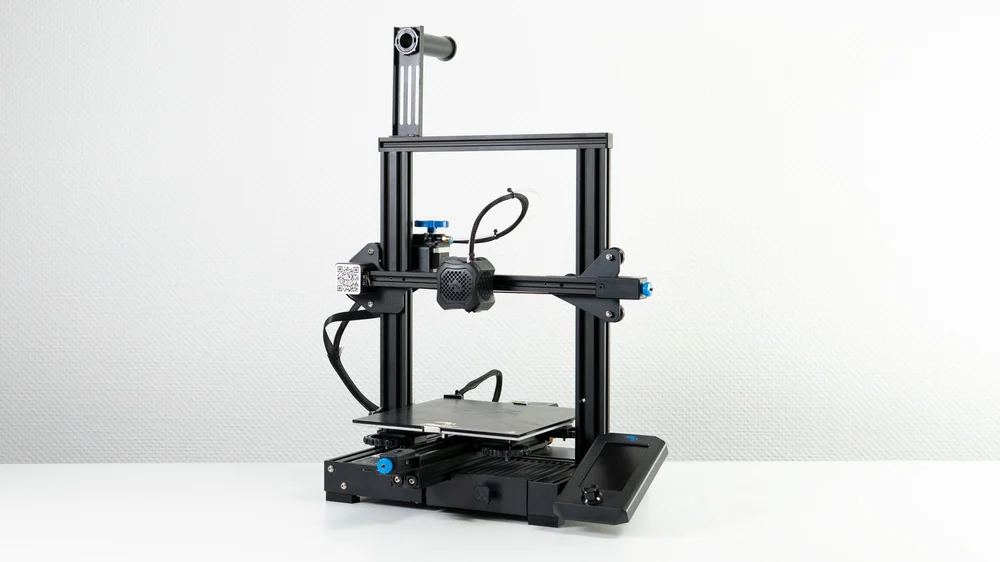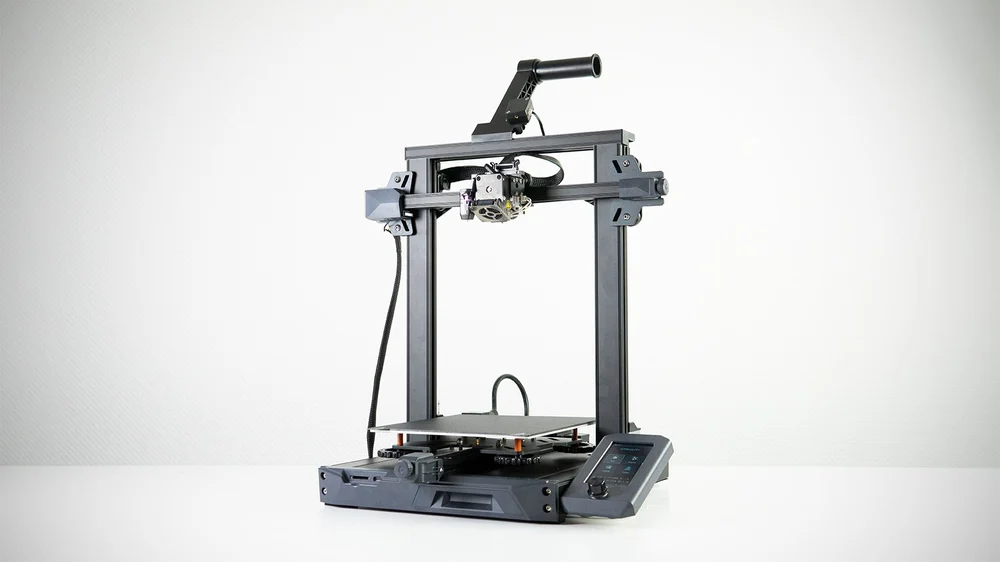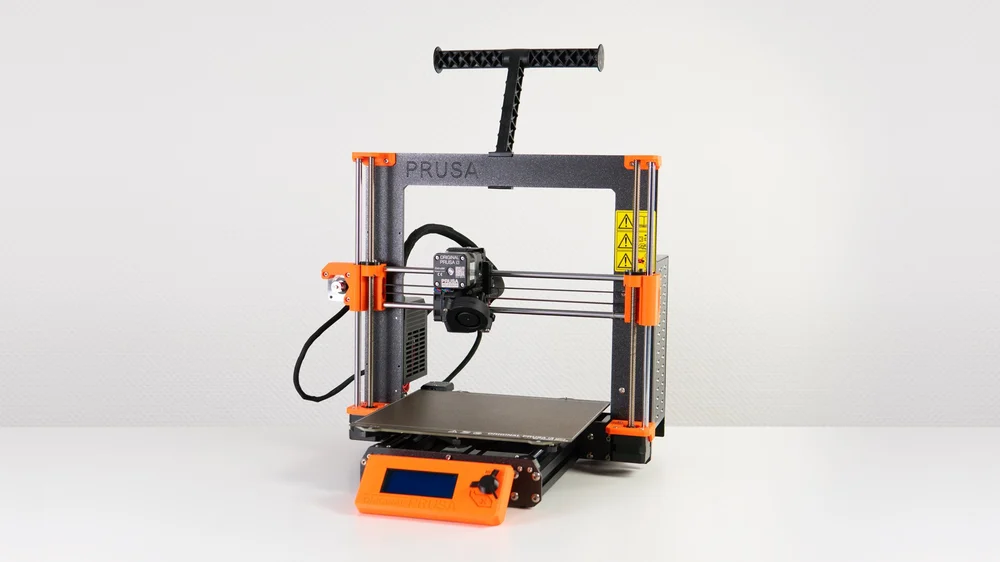Looking for a cheap 3D printer? Check out our buyer’s guide to the best budget 3D printers under $200, $300, $500, and $1,000.
Just a decade ago, the average 3D printer was an industrial fixture costing thousands. Today your typical printer can sit on a desk, and we’ll hazard the guess that it costs a lot less than the device you’re using to read this very text. It’s easier than ever to find an excellent cheap 3D printer for the smallest of budgets. Even $200 will comfortably cover an excellent starter machine that can get you printing within minutes.
Best Budget 3D Printers Under $200, $300, $500 & $1,000
| Under $200: Voxelab Aquila |
Under $300: Creality Ender 3 V2 |
Under $500: Creality Ender 3 S1 |
Under $1,000: Original Prusa i3 MK3S+ |
|
| Market Price (USD, approx.) | $179 | $262 | $429 | From $892 |
| Build Volume | 220 × 220 × 250 mm | 220 × 220 × 250 mm | 220 × 220 × 270 mm | 250 x 210 x 210 mm |
| Temperatures (Nozzle/Bed) |
<250 ℃ / <100 ℃ | <255 ℃ / <100 ℃ | <260 ℃ / <100 ℃ | <300 ℃ / <120 ℃ |
| Feeder System | Bowden | Bowden | Direct dual, geared | Direct dual, geared |
| Print Bed | Glass, textured | Glass, textured | Steel, magnetic, grip sheet | Steel, magnetic, PEI sheet |
| Bed Leveling | Manual | Manual | Automatic-bed leveling, Creality CR-Touch probe | Automatic-bed leveling, SuperPinda probe |
| Print Recovery | Yes | Yes | Yes | Yes |
| Filament Sensor | No | No | Yes | Yes |
| Dimensions | 475 x 480 x 473 mm | 475 x 470 x 620 mm | 487 x 453 x 622 mm | 550 x 400 x 500 mm |
How to Pick a Budget 3D Printer
3D printing on a budget ostensibly means cutting creature comforts for a lower price point. In relative terms of print quality, you won’t see a difference between a $200 printer and a $1,000 3D printer that correlates with the difference in spend.
Instead, the money goes into the quality of components (and therefore longevity, ease of replacement), support, development, and sophistication in the hardware you’re using. A sub-$200 3D printer will be, by most measures, basic, when compared to the self-diagnostic wizardry of a $1,000 machine, but knowing that going into this article, it’s easy to see how the technology scales with the price point.
In this list, we’re focusing on four price brackets, showing you what we feel are the all-rounder 3D printers to be found for under $200, $300, $500, and $1,000. There’s no shortage of other machines that fall under these brackets, too, so while what’s presented here is the sharp edge of our recommendations, watch out for mention of other machines we’ve considered and think are also worth your attention (but just miss out on our top spot.)
Under $200: Voxelab Aquila

When the Voxelab Aquila entered this list in July 2021, it relegated the Anycubic Mega Zero and super-popular Creality Ender 3 to the sidelines. Those two are no slouches, which goes to show just how much this little budget 3D printer impressed us.
To describe it as an underdog would be misleading, because Voxelab is really the budget sub-brand of 3D printing giant, Flashforge. A wolf in sheep’s clothing would be the idiom that springs to mind.
The Voxelab Aquila comes in at a comfortable sum under $200, the first main criteria for our top pick under $200. Actually, the Voxelab Aquila trounces this first, all-important checkbox and can easily be found for closer to $150 than $200, making it an exceedingly good value for money for the capabilities and experience it offers.
Working with the Aquila is a piece of cake thanks to a bright and easy-to-use UI. You get simple, large icons that leave little ambiguity about what they do. That theme continues in the VoxelMaker slicing software, a reskinned version of Flashforge’s Flashprint, that provides just enough functionality for beginners to get to grips with and produce fine prints. For power users, full compatibility with any G-code generating software gives room to grow with the printer.
In testing, we achieved fantastic print quality with little effort. The textured carborundum glass bed works particularly well with ABS and PLA, gripping when hot and releasing prints without trouble when cold. If printing with PETG, we recommend keeping a glue stick on hand for reliable adhesion.
Part cooling is particularly good on the Aquila, handling overhangs with surprising capability for the printer’s price. All in all, an easy recommendation and impressive performance from such an affordable machine – a clear step up on the past under-$200 recommendation, the Ender 3.
Under $300: Creality Ender 3 V2

The Creality Ender 3 V2 is not so much an overhaul of the Ender 3 that came before; more a refinement. Taking the uncomplicated design that served the original so well and sophisticating it with useful additions that make it more workhorse-like and comfortable to use, the Ender 3 V2 continues the series’ character of balancing high-quality printing with, here at $262, a competitive price tag.
As time has marched on, the Ender 3 V2 ends up occupying something of an odd space – it’s a long way from the sophisticated and feature-rich experience that printers approaching $500 will get you – really it’s just the same Ender 3 but a little… extra.
The Creality Ender 3 V2 is not so much an overhaul of the Ender 3 that came before; more a refinement. Taking the uncomplicated design that served the original so well and sophisticating it with useful additions that make it more workhorse-like and comfortable to use, the Ender 3 V2 continues the series’ character of balancing high-quality printing with, here at $262, a competitive price tag.
As time has marched on, the Ender 3 V2 ends up occupying something of an odd space – it’s a long way from the sophisticated and feature-rich experience that printers approaching $500 will get you – really it’s just the same Ender 3 but a little… extra.
For one, the Ender 3 V2 is a few entries deep in Creality’s Ender 3 series, which shows — there’s a refinement here that’s missing from the Aquila. Things like tidier cable routing and the inclusion of a tool drawer in the dead space of the printer’s base give the Ender 3 V2 a more polished feel.
There’s also the little fact that Creality’s Ender 3 series is remarkably popular — countless mods, upgrades, and guides (we’ve made a few) make the Ender 3 V2 an effortless and logical starter or second 3D printer.
Under $500: Creality Ender 3 S1

The frame may look familiar, but in the Ender 3 S1 Creality changes things considerably from the Ender 3 V2, listed above.
Between dual stepper motors to drive the Z-axis movement, the flexible, metal, removable PC-coated print bed, and a sophisticated lightweight print head that introduces a dual, reduction-geared extruder that directly feeds filament to the hot end beneath, the Ender 3 S1 is a marked step up on the Ender 3 machines that came before.
The frame may look familiar, but in the Ender 3 S1 Creality changes things considerably from the Ender 3 V2, listed above.
Between dual stepper motors to drive the Z-axis movement, the flexible, metal, removable PC-coated print bed, and a sophisticated lightweight print head that introduces a dual, reduction-geared extruder that directly feeds filament to the hot end beneath, the Ender 3 S1 is a marked step up on the Ender 3 machines that came before.
Under $1,000: Original Prusa i3 MK3S+

Prusa Research carved a path with the Original Prusa i3 MK2, showing the commercial viability of 3D printers printing essential components to make more 3D printers. Rooted in the RepRap movement, and completely open source, its printers stand as exemplars of what an affordable could, or should, be. Several iterations later, we now have the Original Prusa i3 MK3S+, a smart and incredibly capable desktop 3D printer that can adapt to its environment and simplify the printing process.
The build volume is the smallest on this list, which some may view as limiting, but dual motor-driven Z-axis, with dual, geared direct extruder on top of a custom E3D V6 style hot end over a magnetic PEI-coated print bed make the i3 MK3S+ the most capable machine on this list. It heats to 300 degrees Celsius, meaning hotter filaments such as polycarbonate and Nylon are possible.
The setup guides are excellent and give you an excellent primer on 3D printing beyond even the essentials necessary to operate the machine. Should you opt for the build-it-yourself version (saving hundreds of dollars in the process), you’ll find a long (budget 8 hours from unboxing to being ready to print), but well-illustrated and simple to follow build that results in – no matter your experience in assembling hardware – one of the best desktop 3D printers you’ll likely ever use.
Expect superb print quality, an enthusiastic and helpful community, easy-to-use and sophisticated slicing software, and a host of other features like auto-calibration, a filament sensor, and crash detection. Diligent software and firmware updates enhance the printer further by squashing bugs, improving existing features, even adding new ones.
Sounds fab – and it is – though the Original Prusa i3 MK3S+ is, effectively, cruising its way to retirement. We’re expecting to see its replacement, the Original Prusa MK4, make an appearance this year, which, given Prusa Research’s history of supersedence with its printers (rather than adding to a series and selling both older and newer models) means it’s a safe bet that the MK3S+ will phase out soon.
OTHER MACHINES
There are a lot of 3D printers to consider for $200, $300, $500, and $1,000 budgets. Too many, which is partly why we’ve transformed our buyer’s guides to give even more focused advice on which 3D printers are worth your consideration in a given category right now.
Not to say that the printers missing from our shortlist above aren’t good, either. It’s been challenging to whittle things down, especially from our old style of guide that included many more machines (without better comparison, we’ll admit.)
Take the Original Prusa Mini+, a fine 3D printer that offers much the same experience as its sibling, our $1,000 pick above, the Original Prusa i3 MK3S+. Just shy of $500, it has a much smaller build volume and, in testing, suffered from some minor extrusion issues. Its footprint also spreads across your benchtop, with the filament spool needing its own resting place away from the machine—great printer, but not as flawless an experience as others.
Another machine we can’t pass up mentioning is the immensely popular Anycubic Vyper. Similarish in feature-set to the Creality Ender 3 S1 (sans the fancy Sprite extruder), our experiences with it have been mixed. Our initial test unit was shambolic, forming the backbone of a review that took a much harsher line of the machine than other media outlets. A newer unit we’re testing is better, but clearly subject to design changes since launch. Convenience features such as a full SD card, removable flex bed, and a dual-gear feeding filament make it a fine printer (though we don’t trust that two units of the same machine can be so wildly out of whack from one another.)
We’ve also tested the Artillery Sidewinder X2 and Artillery Genius Pro machines — follow-ups to the company’s successful X1 and Genius direct extruder-toting 3D printers. Neither blew us away, with lackluster print results and manual fiddling required to get optimal results.
Things move fast, and we’ve got an intimidating pile of printers to review this Spring. Expect changes to the recommendations as the year ticks by.
WHAT’S CHANGED?
This article used to be updated quarterly, meaning our recommendations could be anywhere up to three months out of date. That’s not so useful for buying advice. With this in mind, we’ve binned that schedule and moved to a rolling update cycle. The moment we test a printer that deserves to be known, it goes on this list.
Just because a printer drops off this list does not mean it is no longer good – far from it. We’ll be keeping track of all the printers that have been removed and the printers that replaced them here, so you can easily see our past picks and investigate further.
Update — March XX, 2022: What a doozy of an update this month. We’re striving to improve our buyer’s guides for 3D printers, tightening the guides to only include printers that are firm ‘Top Picks’, placing more side-by-side information upfront, and giving longer explanations of why each printer deserves its spot.
Update – October 13, 2021: Despite testing a fair few printers that had the potential to get into this article since July, none have really done enough to warrant inclusion. The Anycubic Vyper, Artillery Hornet, and the Flsun Super Racer didn’t impress us enough to make this list. Neither did the Artillery Sidewinder X2, which can’t knock out its predecessor, falling short thanks to poor print quality and severe Z-wobble issues. As usual, we’ve checked prices and re-ordered the printers a little to reflect price changes and keep them in ascending price order. As you might have noticed, the Top Picks have also changed, now reflecting what we feel are the best 3D printers under $200, $300, and $500, reflecting the more budgety nature of this article.
Update – July 22, 2021: Despite being very good budget 3D printers, the Anycubic Mega Zero and the Creality Ender 3 have departed the list, replaced by the excellent Voxelab Aquila we’ve just reviewed. The Prusa Mini+ has also displaced the Artillery Sidewinder X1 as a top pick, getting the nod from All3DP editors. Everything else remains the same, but we’ve improved and updated some links and checked (and updated where needed) prices too.
Update – February 15, 2021: Into the list comes the Biqu B1 and the Flashforge Creator Pro 2, with the latter knocking out the Qidi Tech X-Pro. The Creator Pro 2 performed well when reviewed in the office and represents a viable upgrade on the X-Pro, while the Biqu B1 has made a very strong first impression on us and looks to be a great alternative to the ever-popular Ender 3 V2.
Update – November 25, 2020: Incorporated the Original Prusa i3 MK3S+ and Original Prusa Mini+, the recent “usability” upgrades that replace those printers in Prusa’s lineup.
Update – November 20, 2020: This update sees the removal of the Flashforge Finder and Creality Ender 5 Pro. The Finder shows its age and holds on to a price point out of step with the rest of the market. Similarly, we find it hard to recommend the Ender 5 Pro wholeheartedly when similar money bags you the all-singing, all-dancing CR-6 SE. If you need the build volume, then the Mega X offers better value.
Source: https://all3dp.com/1/best-3d-printer-reviews-top-3d-printers-home-3-d-printer-3d/